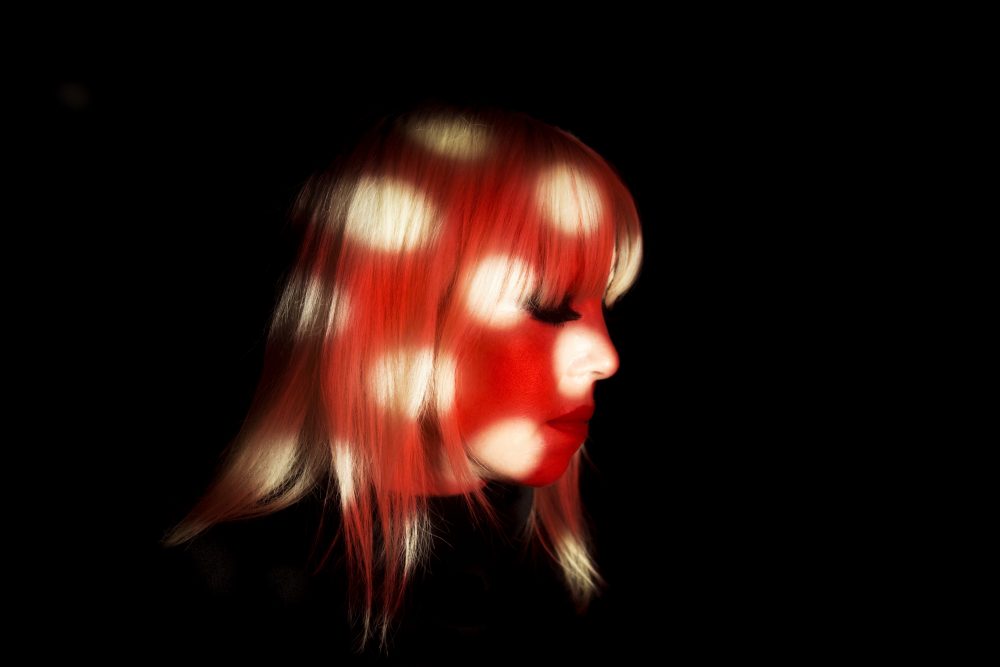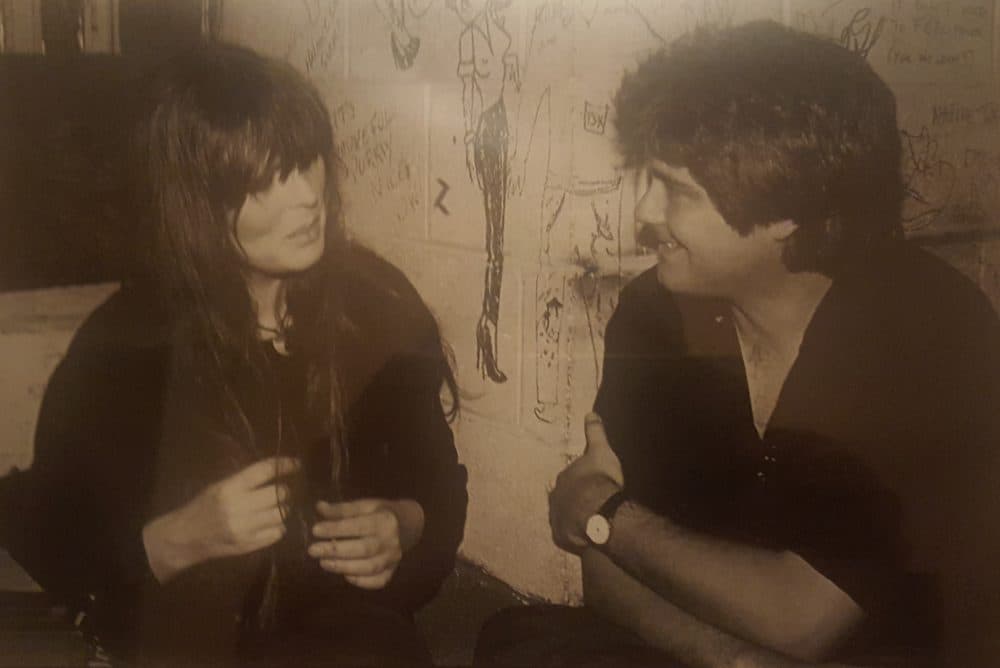Advertisement
Dark And Mysterious Velvet Underground Singer Nico Brought Into The Light At Oberon

Nico lives. Sort of.
The enigmatic one-time singer for the Velvet Underground and dark chanteuse of the post-punk in the late-‘70s and ‘80s died 29 years ago after falling from her bicycle in Ibiza. But on Saturday night, performer Tammy Faye Starlite is re-envisioning (or re-animating) Nico at Oberon in Cambridge.
The New Jersey-based singer/actress is performing “Nico: An Evening of Light” — a 12-song show peppered with Nico-esque talk — as part of the weekend’s GLOW Festival at American Repertory Theater’s alternative stage. (You may remember GLOWBERON in previous years at the club. This is organizer Quinn Cox’s related effort to preserve Cambridge’s legacy of progressive and fringe performing arts.) Starlite will be joined for this performance by electric guitarist Richard Feridun.
The star of their show, the late Nico, was born Christa Päffgen in Germany. She achieved fame as a model in Paris and Rome in the late 1950s. She had a minor part in Fellini’s “La Dolce Vita” and, in the ‘60s became one of Andy Warhol’s “superstars” appearing in “Chelsea Girls.” Rock fans got to know her through the Velvet Underground’s debut album and her six solo albums from 1967 to 1985.
I first met Nico in back in 1979 after she played the Paradise in Allston. She played harmonium and sang, accompanied by her young guitarist/boyfriend Lutz Ulbrich. It was a fragile show, full of stops and starts, as if it all might fall apart at any moment. But the audience was pulling for her — there was pin-drop quiet when she struggled between songs. Nico was far from a great singer, and being on key was not her forte. It may have been shambolic, but there was a deep, dark emotional pull to most everything she touched.
I had time scheduled with her post-show, but after a long wait I found out someone else had interviewed her, claiming to be me. She was a little shaken so we rescheduled for the next day at the bar of her hotel.
She was — no surprise — late. "I woke up three times," Nico said, upon arrival, "and the last one was the best. I remained in a good mood. Sometimes, you wake up and it's really terrible ... as if ... the whole thing would collapse."
She was dressed in baggy black, her hair dyed black, her eyeliner black. She was unnerved by the appearance of a photographer. She was not a model, not anymore.
Nico spoke as she sang. Hers was a deep, heavily accented voice, which even during lighter moments, seemed touched with sadness. That sadness was there when she sang, her contralto rendering most everything in monotonic shades of black or gray, even during “up” songs like David Bowie’s “Heroes.”
She attributed her worldview — and the music she was drawn to and wrote — to growing up in Berlin during World War II. In 1943, when she was 5, she told me her father was killed by the Nazis.
"That's how you get when you are writing and you have lived through the war," she told me, over a breakfast of bloody marys and cheddar goldfish on a rainy afternoon in that Cambridge hotel 38 years ago. "Always writing about gloomy things.”
"There's a sort of happiness about sad things."
Nico
“There's a sort of happiness about sad things," she added.
Let’s leave the real Nico behind for a moment. Tammy Lang-Hartel first created her Starlite character in the ‘90s. She was doing alt-cabaret and the character she portrayed was, she says, “a country-singing, right-wing evangelical filthy person.” Lang-Hartel kept Starlite as her professional name, as she went on to do other shows, including a “Broken English”-era Marianne Faithfull, mixing songs and improvised chat.

Starlite, who is 50, was not even a toddler when Nico sang on 1967’s “The Velvet Underground & Nico” album. But she says she picked up Nico’s personality through records, of course, videos and Susanne Ofteringer’s spot-on 1995 documentary, “Nico Icon.”
“I basically immerse myself in books I've read and re-watch videos and DVDs and listen to interviews,” says Starlite, on the phone from her Hoboken home. “I simply try to manifest what physical and vocal characteristics I can, and to be truthful, in as much as impersonation can be truthful. Also, I go for the subversion, nihilism and solipsism, all of which I find fascinating and beautiful.”
Heroin was Nico’s longtime companion. It’s something Starlite doesn’t refer to explicitly in her show, but draws upon: “I have that knowledge in me and for this performance she’s gotten her heroin, because otherwise she’d be freaking out. She’d be jonesing and scratching. It just comes out in the languor of her speech, her responses to things.”
In the many videos she has watched of Nico, Starlite says, “there’s nothing to suggest heroin except when you look really closeup and you see that her pupils are so tiny, they’re tinier than the tiniest atom. She spoke in a slower way, but not in a slurred way.
“A lot of things people see as detrimental in terms of people’s character, things that could be considered their flaws, that’s part of their humanity,” Starlite continues. “People cope with things in different ways and for people who use heroin there might be subconscious reasons that may never reach a semi-conscious level. Sometimes, the reasons are just too unknowable.”
Starlite has been doing a Nico show of some sort since 2014, the first one scripted and including music through Nico’s final album, 1985’s "Camera Obscura."
“Nico’s voice entranced me, the depth and lack of affect,” Starlite says, “but you knew that there was something beneath the surface. I don’t know what other people’s process is, but for me it’s finding the external life, the movements or non-movements. Her eyes were very expressive, but there was nothing phony about her. She didn’t have any showbiz to her.”
Starlite has met and talked with several of Nico’s friends including one-time accompanist Jackson Browne, Warhol director Paul Morrissey and, especially, Danny Fields, the former Ramones manager who signed Nico as a solo artist to Elektra Records.
She’s garnered praise from the New York Times, the Los Angeles Times and Rolling Stone, with the latter’s David Fricke writing, “Starlite has the proper blonde hair and packs an accent just the right side of exaggeration. She punctuates Nico's fondly blunt and drolly unforgiving characterizations of Bob Dylan (who gave her the immortal "I'll Keep It With Mine") the Velvets' Lou Reed ("a usurper of souls") and the teenage Jackson Browne (her accompanist for a spell after the Velvets) with regal sweeps of hair and exasperated stares, her eyes as wide as headlights.”
Starlite says “Nico: An Evening of Light” will include the Gordon Lightfoot-penned "I'm Not Sayin' ” (her first single, released before her debut album in 1965), the Velvet Underground’s “Femme Fatale” and “All Tomorrow’s Parties,” Browne’s “These Days” and the Doors’ "The End.” (Browne and the Doors’ Jim Morrison were one-time lovers of Nico’s.)
As to the between-song chat during the 75-minute show, Starlite says, “I'll improvise dialogue between songs, often non-sequiturial, some actual quotes, some talking about whatever's going on that week, politically and culturally. I have bits and stock lines, but there’s always something newer coming.”
Starlite’s method, she says, comes from studying with actor-director Austin Pendleton. He told her, " 'Every character has a question — what do I want?' And you don’t always have to know the answer. But you always keep asking the question and that is liberating."
Starlite says the Nico she presents is a mix of eras: “The hair is '60s, the black outfit is '70s and '80s, and internally it’s more of the latter-day Nico.”
“I always think the whole of a person is much more interesting than what people perceive as the best parts of a person, the better angel,” Starlite says.
“I always think the whole of a person is much more interesting than what people perceive as the best parts of a person, the better angel.”
Tammy Faye Starlite
People sometimes laugh, uncomfortably perhaps, at the things Starlite says as Nico. One might posit that there’s an element of mocking. Not at all, Starlite says.
“I try to go in there and do what she would do,” says Starlite. “I don’t want to ever do anything that seems kitschy or obvious or mocking. Although, she would mock people and it could be seen as me mocking her in what I do, but I guess that’s OK. It’s the nature of tautology, I guess.”
Starlite doesn’t try to unlock the enigma that was Nico. "There’s always the question of why she’s doing what she’s doing. Why did she willfully destroy her own beauty in a certain way? Why did she end up the way she was? She would say — or she might say — that she was a fatalist," Starlite says. "Things happen through fate, not luck or chance so, she would say she was fated to have this life and she had no idea what goes on beyond this life."
The last time I saw Nico was in 1982. She played a gig with a four-piece English band at the long-defunct club Jonathan Swift's in Harvard Square. She was in better shape than she had been three years before.

She was certainly more animated, more outwardly amiable. "I'm very constructive, I'm not only destructive. You have to be or else you're a loser," she said, backstage in the cramped, graffiti-plastered dressing room.
Nico spoke of her 1979 performance at the Paradise as a "disaster — I was, like, really ready to kill myself." A fan backstage asked for her autograph. She signed it: "Do or Die — Nico."




